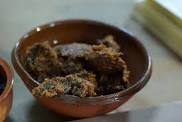“Anything green that grew out of mould was an excellent herb to our fathers of old”
So wrote Rudyard Kipling when describing the English medieval addiction to herbs and spices – the more exotic the better. And surely there is none more exotic than Alpinia officinarum, or lesser Galangale, now simply known as galangal although, in reality, there are actually four different varieties of the herb. A knobby, sallow root that grows from the rhizomes of the ginger family (zingiberaceae), it appears to have travelled from China to Arabia and was then introduced into Europe either as early as the tenth century or in the late eleventh century. In 1179, St. Hildegard of Bingen, the famed German herbalist and mystic, refers to it as “catarrh root” and “the spice of life” in her seminal work “Physica”. She provides a snuff-like treatment for the relief of colds and sinus inflammation and considering its powerful scent – a spicy mixture of ginger and mustard with a hot, bitterly medicinal taste – it’s fairly obvious that it would apply quite a shock to the olfactory system.
She also pressed galangal, along with pellitory (a perennial that resembles chamomile) and white pepper into pill form for heart pain. But, like ginger, she used it primarily as a digestive and relief of upset stomach and seasickness. Today, homeopaths used it both for stomach complaints and in aiding blood circulation.
For culinary purposes, both the French and English medieval people incorporated galangal in prepared dishes but it seems to have been mainly used as an ingredient in a sauce called “Rapeye.” This sauce is thickened with dried fruit, boiled in wine and various spices and served with meat or fish. Rapeye also was used in meat or fish pasties. Some modern cookbooks suggest adding it in dishes for its mustardy depth of flavor.
Today, galangal is primarily used in Asian cookery – particularly Thai and Indonesian cuisines. In Europe, it seems mostly confined to a flavoring for alcohol in Lithuania and Estonia. Russia has a galangal vodka called Nastoika. And last but not least, the artisanal soft drink community – from Baghdad to London to Brooklyn – has now introduced a new soda with a kick that would surely have pleased our medieval ancestors.
Here are two medieval recipes that might be adapted for the modern palate:
From The Forme of Cury, 1390
Rapeye:
Take half fyges and half raisins pike them and waisshe them in water skalde them in wine. Bray them in a morter, and draw them through a strainer. Cast them in a pot and therwith powder of pepper and oother good powders. Alay it up with flour of Rice. And colour it with sanders (sandalwood), salt it and present it forth.
From Fabulous Feasts by Madeleine Pelner Cosman:
Arbolettys (A spiced cheese dish)
4 eggs
1/2 teaspoon salt
1 cup of milk
3 tablespoons butter
1 cup ricotta or cottage cheese
1 teaspoon fresh parsley
1/2 teaspoon ground sage
3/4 teaspoon finely grated candied ginger
1/4 teaspoon galingale
Garnish:
1/2 teaspoon cinnamon
1 teaspoon sugar
Beat the eggs and salt with a fork and set aside. In a large enameled pot, gently heat the milk, butter and cheese, stirring intermittently until the mixture is smooth and slowly simmering. Slowly beat 1/2 cup of the hot liquid into eggs, stirring constantly to avoid curdling. Add the eggs to pot and stir; simmer for two minutes, stirring while custard thickens. Remove from heat. Mix parsley, sage, ginger and galingale and stir into the pot. Spoon into one large serving dish and sprinkle cinnamon and sugar on top. Serve warm.
Galangal can be found at Asian food markets. It is not recommended as a substitute for ginger.
 A version of Arbolettys served with toast
A version of Arbolettys served with toast
*The dish shown in the delightful painting at the top is called “Mulahwajah” – an Arab word meaning “hasty.” It is a quickly prepared lamb dish made with galangal and various spices including what appears to be leeks and garlic.
Special thanks to Kitchen Doctor, “Galangal” by Ingred Naiman




